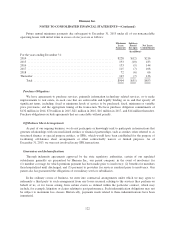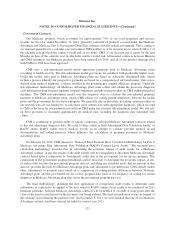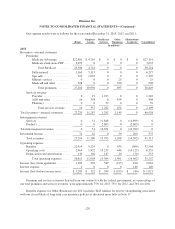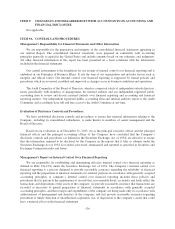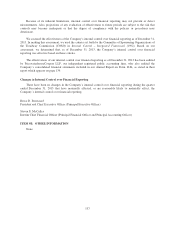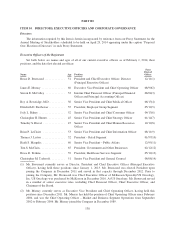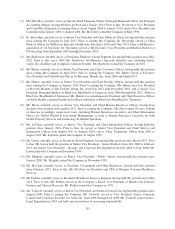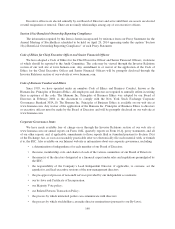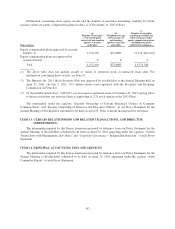Humana 2013 Annual Report Download - page 142
Download and view the complete annual report
Please find page 142 of the 2013 Humana annual report below. You can navigate through the pages in the report by either clicking on the pages listed below, or by using the keyword search tool below to find specific information within the annual report.Humana Inc.
NOTES TO CONSOLIDATED FINANCIAL STATEMENTS—(Continued)
During 2013, we recorded a loss for a premium deficiency. The premium deficiency was based on current
and anticipated experience that had deteriorated from our locked-in assumptions from the previous December 31,
2010 loss recognition date, particularly as they related to emerging experience due to an increase in life
expectancies and utilization of home health care services. Based on this deterioration, and combined with lower
interest rates, we determined that our existing future policy benefits payable, together with the present value of
future gross premiums, associated with our closed block of long-term care insurance policies were not adequate
to provide for future policy benefits and maintenance costs under these policies; therefore we unlocked and
modified our assumptions based on current expectations. Accordingly, during 2013 we recorded $243 million of
additional benefits expense, with a corresponding increase in future policy benefits payable of $350 million
partially offset by a related reinsurance recoverable of $107 million included in other long-term assets.
During 2012, we recorded a change in estimate associated with future policy benefits payable for our
closed-block of long-term care insurance policies resulting in additional benefits expense of $29 million. This
change in estimate was based on current claim experience demonstrating an increase in the length of the time
policyholders already in payment status remained in such status. Future policy benefits payable was increased to
cover future payments to policyholders currently in payment status.
Deferred acquisition costs included $66 million and $62 million associated with our individual commercial
medical policies at December 31, 2013 and December 31, 2012, respectively. Future policy benefits payable
associated with our individual commercial medical policies were $327 million at December 31, 2013 and $282
million at December 31, 2012. As discussed in Note 2, beginning in 2014, health policies sold to individuals that
conform to the Health Care Reform Law will be accounted for under a short-duration model because premiums
received in the current year are intended to pay anticipated benefits in that year.
18. REINSURANCE
Certain blocks of insurance assumed in acquisitions, primarily life, long-term care, and annuities in run-off
status, are subject to reinsurance where some or all of the underwriting risk related to these policies has been
ceded to a third party. In addition, a large portion of our reinsurance takes the form of 100% coinsurance
agreements where, in addition to all of the underwriting risk, all administrative responsibilities, including
premium collections and claim payment, have also been ceded to a third party. We acquired these policies and
related reinsurance agreements with the purchase of stock of companies in which the policies were originally
written. We acquired these companies for business reasons unrelated to these particular policies, including the
companies’ other products and licenses necessary to fulfill strategic plans.
A reinsurance agreement between two entities transfers the underwriting risk of policyholder liabilities to a
reinsurer while the primary insurer retains the contractual relationship with the ultimate insured. As such, these
reinsurance agreements do not completely relieve us of our potential liability to the ultimate insured. However,
given the transfer of underwriting risk, our potential liability is limited to the credit exposure which exists should
the reinsurer be unable to meet its obligations assumed under these reinsurance agreements.
Reinsurance recoverables represent the portion of future policy benefits payable that are covered by
reinsurance. Amounts recoverable from reinsurers are estimated in a manner consistent with the methods used to
determine future policy benefits payable as detailed in Note 2. Reinsurance recoverables, included in other long-
term assets, were $578 million at December 31, 2013 and $461 million at December 31, 2012. The percentage of
these reinsurance recoverables resulting from 100% coinsurance agreements was approximately 37% at
December 31, 2013 and approximately 48% at December 31, 2012. Premiums ceded were $33 million in 2013
and $34 million in each of 2012 and 2011.
132


